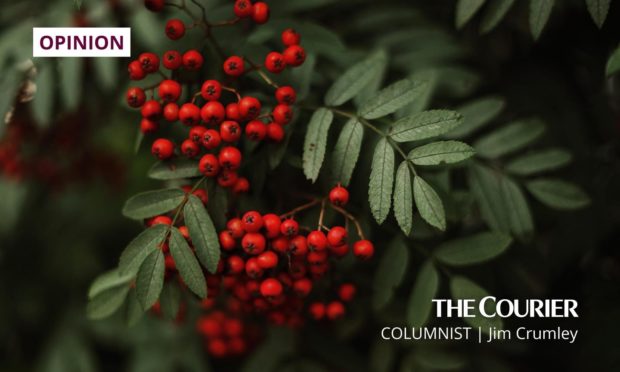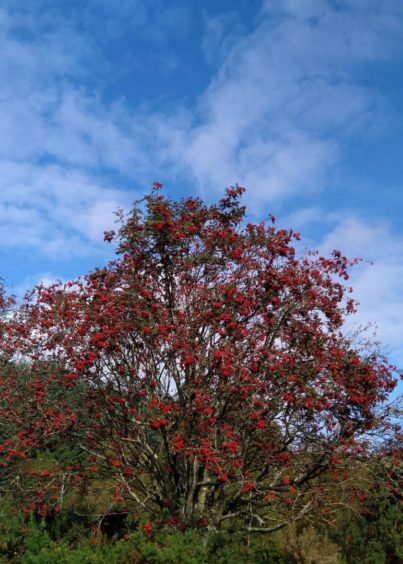I know, I know, we’re mid-pandemic with no end in sight.
There is muttering in the iniquitous dens of Westminster about an energy crisis.
The supermarket shelves are empty because Brexit was the worst decision in recent political history (which is an extravagant boast but true none the less).
And United won on Sunday.
And all of that makes the world look a pretty grim place right now.
But tell me this: was there ever such a September for rowan berries?

I was wandering a stretch of the Great Trossachs Path above Loch Venachar.
It’s a regular haunt of mine.
The land is a Woodland Trust Scotland reserve and I have watched it transform almost weekly over a little more than 20 years.
The result is a considerable accomplishment of nature conservation.
It is an object lesson in native woodland restoration that now pleases golden eagles, pine martens, beavers, and a tumultuous summer population of willow warblers.
And all that is quite apart from passing prowlers with notebooks, like me.
It was a beautiful warm afternoon.
The light had acquired that mysterious yellow tinge with which summer is unfamiliar.
And given that autumn is my time of the year, all was well with my world.
Blazing red of rowan berries
Loch Venachar was flat calm and the hills and forests of the far shore were back-lit into silhouette so that the reflections they cast on the water were deep black.
Where spars of sunlight pierced the trees, the water they lit was the shade of snow.
And almost everywhere I looked above the north shore of the loch, somewhere along my sightline there were rowan trees, practically throbbing with the weight of berries.
Rowans reach that point in September when they dispense with leaves without much fuss leaving bright red trees in their wake
Many were newly planted. But others were veterans given a new lease of life by the infinitely more benevolent regime that the Woodland Trust has brought to bear here.
Rowans reach that point in September when they dispense with leaves without much fuss leaving bright red trees in their wake.
In deep shadow or on dull days these acquire a mellow glow the way that stained glass does.
But in unfettered sunlight, they blaze.
The path curved and climbed and opened a new sightline, a steep bank encrusted with bramble and whin.
It was topped with a crescent of nine rowans – and these were against the sky.
I found it strange that I had never noticed them before. But what was eye-catching about them at that moment was that they blazed red against an unblemished deep-blue sky.
It was impossible not to have your head turned.
I stopped. And I sat. And I stared.
Rowan trees and eagles belong together
Rowan trees have always had a particular place in my affections. It’s a character trait I seem to share with golden eagles.
Many a Highland eyrie looks to a wiry old cliff-face rowan of no great size but limitless strength for its foundation stone, and builds on it year after year.
Many a Highand golden eagle furnishes and freshens the lining of the nest cup on an almost daily basis with sprigs of rowan.
The connection is deep and ancient.
Rowans find sustenance in the unlikeliest of places.
Seton Gordon, Highland naturalist and writer of distinction, and a golden eagle specialist, wrote in his 1925 book, The Cairngorm Hills of Scotland, about one that was “growing upon the uprooted stump of an old pine, and so was out of reach of the deer that destroy every seedling in Glen Derry and Glen Lui”.
He went on: “This mountain ash had thrust its main root down through the air below the eminence on which it grew, and into the level earth beneath.
“It had thus two root systems, one of them several feet below the other”.
In the same book he mentions finding one “sadly eaten by deer” at just over 3,000 feet and near Loch Coire an Lochain on Braeriach.
This is an exceptional occurrence for a tree that is very rare anywhere above 2,000 feet.
I have been to that rarefied loch twice and never seen a rowan there.
Bearing in mind that he was writing around 100 years ago, that’s hardly surprising.
But I do wonder if it ever produced berries some rare benevolent old September at such an altitude on a such a blasted mountainside.
Both species are thriving here again
The golden eagle has found its way back to Glen Finglas after the dark years of the forestry industry’s reign here.
Now, as young trees swarm up and across hillsides, I like to think that the presence of rowans in such numbers is a factor in the eagle’s decision-making.
Many plant species on the #GlenFinglas estate are adapted to relatively hostile environments, withstanding cold temperatures and fierce, biting winds.
They’re often found growing tucked away in gullies, cracks and crevices https://t.co/d4tthrGM9B #25YearsGlenFinglas pic.twitter.com/bWYYmjSNOf
— Woodland Trust🌳 (@WoodlandTrust) September 19, 2021
The writer Hugh Johnson paid the rowan this tribute in his book Trees, acknowledging that it is “like the Scots pine, identified inextricably with Scotland”
“I have seen landscapes in which full dress tartan would simply have disappeared into the background as a perfect disguise,” he wrote.
“The heather gives a purple ground on which the larches and the birches display their yellow gold. The rowan is gold of a richer hue, set with preposterous carbuncles of scarlet fruit.”
Good eh?
So go for a walk where rowans thrive some fine September day, and forget the woes of the world.

